Nicholas P. Cheremisinoff. Handbook of Solid Waste Management and Waste Minimization Technologies
Подождите немного. Документ загружается.


Clean-out Hole - Hole or port that is provided for inspection and maintenance
purposes.
Clean Water Organisms - The association or ecological balance of many species
that are found in an unpolluted environment. Attempts are made to use these as a
measure of pollution. The same is true of polluted water organisms.
Clear Cut - Harvesting all the trees in one area at one time, a practice that destroys
vital habitat and biodiversity and encourages rainfall or snowmelt
runoff,
erosion,
sedimentation of streams and lakes, and flooding.
Climate Change - This term is commonly used interchangeably with "global
warming" and "the greenhouse effect," but is a more descriptive term. Climate
change refers to the buildup of man-made gases in the atmosphere that trap the sun's
heat, causing changes in weather patterns on a global scale. The effects include
changes in rainfall patterns, sea level rise, potential droughts, habitat loss, and heat
stress.
The greenhouse gases of most concern are carbon dioxide, methane, and
nitrous oxides. If these gases in our atmosphere double, the earth could warm up by
1.5 to 4.5 degrees by the year 2050, with changes in global precipitation having the
greatest consequences.
Cloning - In biotechnology, obtaining a group of genetically identical cells from a
single cell; making identical copies of a gene.
Close-coupled Pump - A type of pump in which the pump shaft is integral with the
motor shaft.
Closed Conduit - Any closed artificial or natural duct for conveying fluids.
Closure - The procedure an operator must go through when a landfill reaches the
legal capacity for solid waste. No more waste can be accepted and a cap usually is
placed over the site. The cap is then planted with grasses and other ground covers.
Post-closure care includes monitoring ground water, landfill gases, and leachate
collection systems, sometimes for as long as 30 years.
Coagulant - (1) A simple electrolyte, typically an inorganic salt containing a
multivalent cation of iron, aluminum, or calcium (for example, FeCl
3
, FeCl
2
,
A1
2
(SO
4
)
3
, and CaO). (2) An inorganic acid or base that induces coagulation of
suspended solids.
Coagulant Aid - Any material that substantially aids coagulation and/or flocculation
but which would not function as a coagulant alone. Such materials are usually highly
selective, and the dose is critical depending upon raw water conditions. They are
widely diverse compounds, a few of which are clays, agar, gelatin, sodium silicate
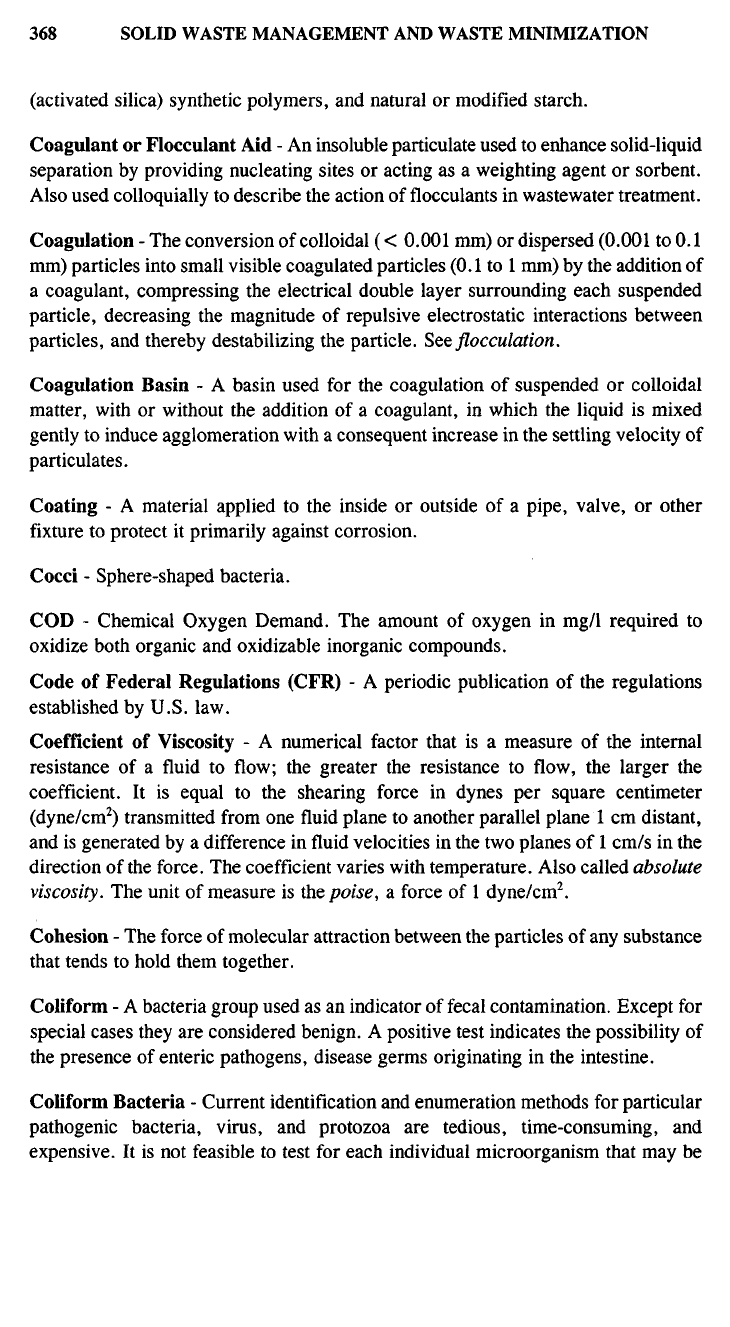
(activated silica) synthetic polymers, and natural or modified starch.
Coagulant or Flocculant Aid - An insoluble paniculate used to enhance solid-liquid
separation by providing nucleating sites or acting as a weighting agent or sorbent.
Also used colloquially to describe the action of flocculants in wastewater treatment.
Coagulation - The conversion of colloidal (< 0.001 mm) or dispersed (0.001 to 0.1
mm) particles into small visible coagulated particles (0.1 to 1 mm) by the addition of
a coagulant, compressing the electrical double layer surrounding each suspended
particle, decreasing the magnitude of repulsive electrostatic interactions between
particles, and thereby destabilizing the particle. Seeflocculation.
Coagulation Basin - A basin used for the coagulation of suspended or colloidal
matter, with or without the addition of a coagulant, in which the liquid is mixed
gently to induce agglomeration with a consequent increase in the settling velocity of
particulates.
Coating - A material applied to the inside or outside of a pipe, valve, or other
fixture to protect it primarily against corrosion.
Cocci - Sphere-shaped bacteria.
COD - Chemical Oxygen Demand. The amount of oxygen in mg/1 required to
oxidize both organic and oxidizable inorganic compounds.
Code of Federal Regulations (CFR) - A periodic publication of the regulations
established by U.S. law.
Coefficient of Viscosity - A numerical factor that is a measure of the internal
resistance of a fluid to flow; the greater the resistance to flow, the larger the
coefficient. It is equal to the shearing force in dynes per square centimeter
(dyne/cm
2
) transmitted from one fluid plane to another parallel plane 1 cm distant,
and is generated by a difference in fluid velocities in the two planes of 1 cm/s in the
direction of the force. The coefficient varies with temperature. Also called absolute
viscosity. The unit of measure is the poise, a force of 1 dyne/cm
2
.
Cohesion - The force of molecular attraction between the particles of any substance
that tends to hold them together.
Coliform - A bacteria group used as an indicator of fecal contamination. Except for
special cases they are considered benign. A positive test indicates the possibility of
the presence of enteric pathogens, disease germs originating in the intestine.
Coliform Bacteria - Current identification and enumeration methods for particular
pathogenic bacteria, virus, and protozoa are tedious, time-consuming, and
expensive. It is not feasible to test for each individual microorganism that may be
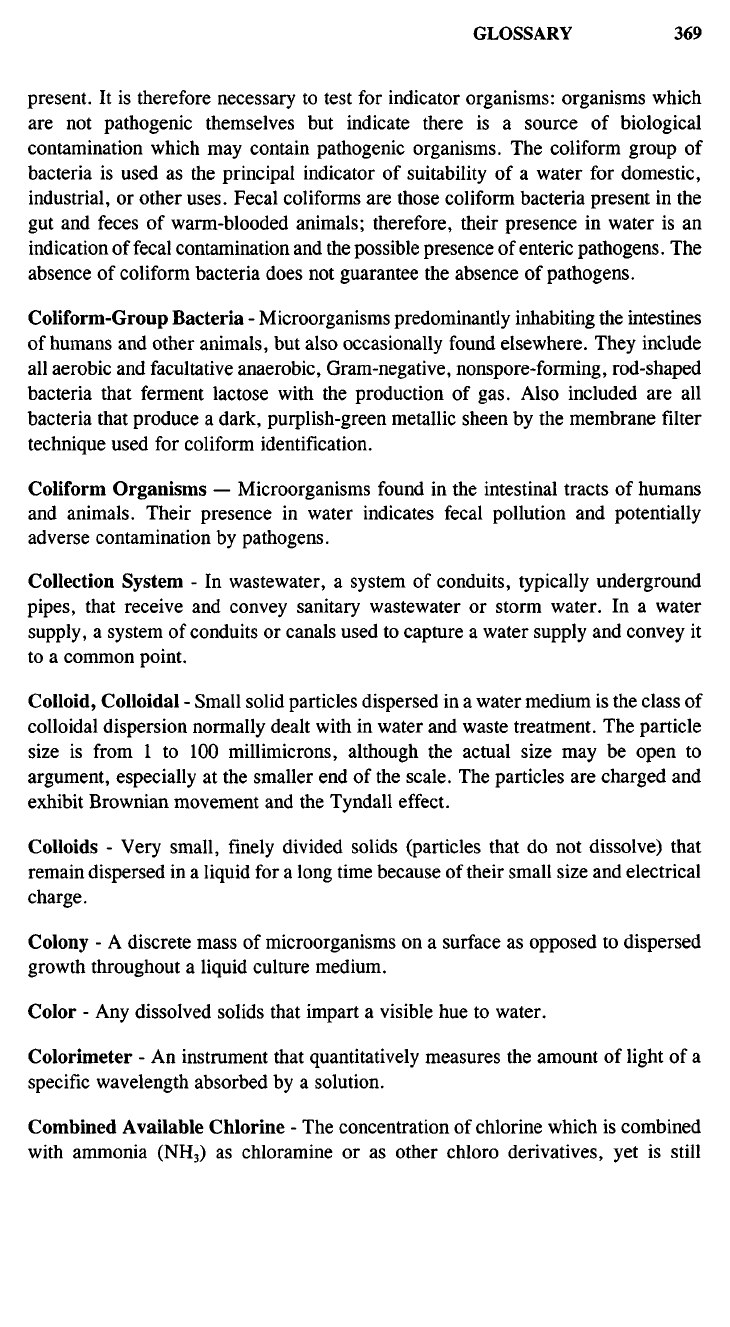
present. It is therefore necessary to test for indicator organisms: organisms which
are not pathogenic themselves but indicate there is a source of biological
contamination which may contain pathogenic organisms. The coliform group of
bacteria is used as the principal indicator of suitability of a water for domestic,
industrial, or other uses. Fecal coliforms are those coliform bacteria present in the
gut and feces of warm-blooded animals; therefore, their presence in water is an
indication of fecal contamination and the possible presence of enteric pathogens. The
absence of coliform bacteria does not guarantee the absence of pathogens.
Coliform-Group Bacteria - Microorganisms predominantly inhabiting the intestines
of humans and other animals, but also occasionally found elsewhere. They include
all aerobic and facultative anaerobic, Gram-negative, nonspore-forming, rod-shaped
bacteria that ferment lactose with the production of gas. Also included are all
bacteria that produce a dark, purplish-green metallic sheen by the membrane filter
technique used for coliform identification.
Coliform Organisms — Microorganisms found in the intestinal tracts of humans
and animals. Their presence in water indicates fecal pollution and potentially
adverse contamination by pathogens.
Collection System - In wastewater, a system of conduits, typically underground
pipes,
that receive and convey sanitary wastewater or storm water. In a water
supply, a system of conduits or canals used to capture a water supply and convey it
to a common point.
Colloid, Colloidal - Small solid particles dispersed in a water medium is the class of
colloidal dispersion normally dealt with in water and waste treatment. The particle
size is from 1 to 100 millimicrons, although the actual size may be open to
argument, especially at the smaller end of the scale. The particles are charged and
exhibit Brownian movement and the Tyndall effect.
Colloids - Very small, finely divided solids (particles that do not dissolve) that
remain dispersed in a liquid for a long time because of their small size and electrical
charge.
Colony - A discrete mass of microorganisms on a surface as opposed to dispersed
growth throughout a liquid culture medium.
Color - Any dissolved solids that impart a visible hue to water.
Colorimeter - An instrument that quantitatively measures the amount of light of a
specific wavelength absorbed by a solution.
Combined Available Chlorine - The concentration of chlorine which is combined
with ammonia (NH
3
) as chloramine or as other chloro derivatives, yet is still
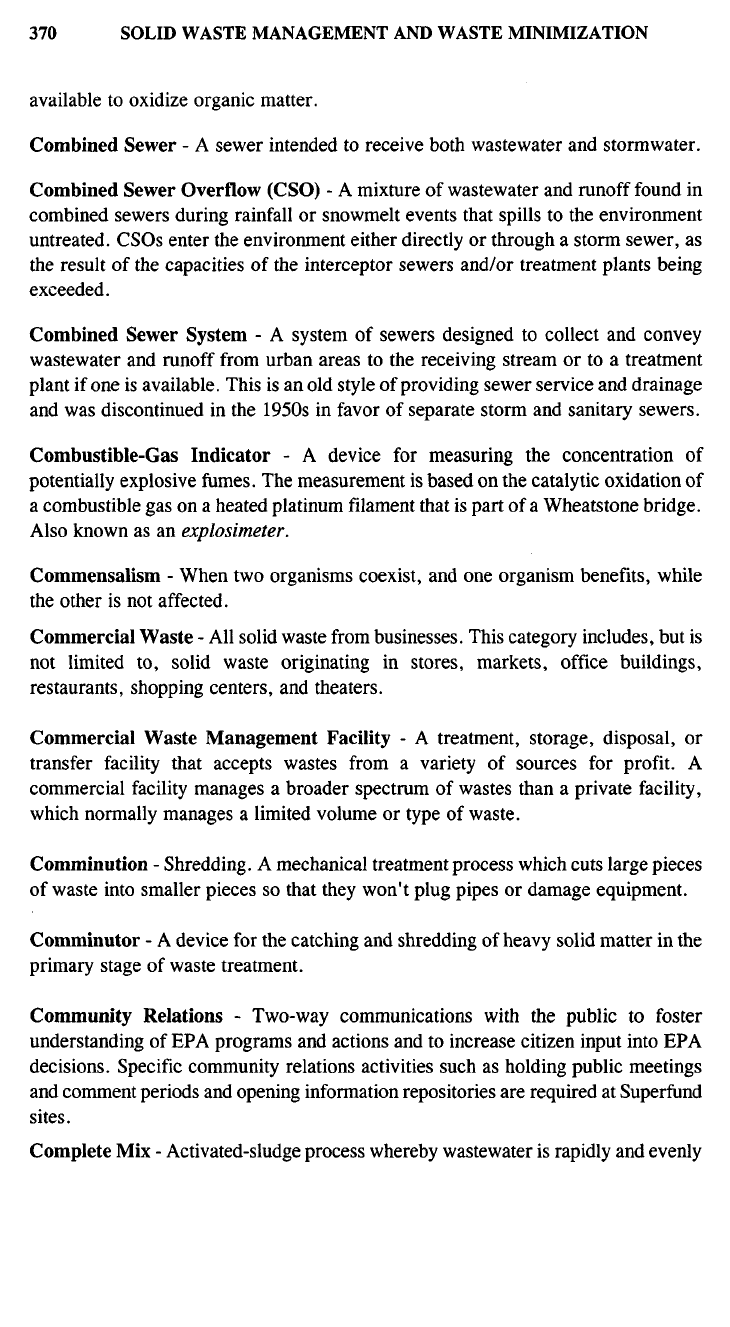
available to oxidize organic matter.
Combined Sewer - A sewer intended to receive both wastewater and stormwater.
Combined Sewer Overflow (CSO) - A mixture of wastewater and runoff found in
combined sewers during rainfall or snowmelt events that spills to the environment
untreated. CSOs enter the environment either directly or through a storm sewer, as
the result of the capacities of the interceptor sewers and/or treatment plants being
exceeded.
Combined Sewer System - A system of sewers designed to collect and convey
wastewater and runoff from urban areas to the receiving stream or to a treatment
plant if one is available. This is an old style of providing sewer service and drainage
and was discontinued in the 1950s in favor of separate storm and sanitary sewers.
Combustible-Gas Indicator - A device for measuring the concentration of
potentially explosive fumes. The measurement is based on the catalytic oxidation of
a combustible gas on a heated platinum filament that is part of a Wheatstone bridge.
Also known as an explosimeter.
Commensalism - When two organisms coexist, and one organism benefits, while
the other is not affected.
Commercial Waste - All solid waste from businesses. This category includes, but is
not limited to, solid waste originating in stores, markets, office buildings,
restaurants, shopping centers, and theaters.
Commercial Waste Management Facility - A treatment, storage, disposal, or
transfer facility that accepts wastes from a variety of sources for profit. A
commercial facility manages a broader spectrum of wastes than a private facility,
which normally manages a limited volume or type of waste.
Comminution - Shredding. A mechanical treatment process which cuts large pieces
of waste into smaller pieces so that they won't plug pipes or damage equipment.
Comminutor - A device for the catching and shredding of heavy solid matter in the
primary stage of waste treatment.
Community Relations - Two-way communications with the public to foster
understanding of EPA programs and actions and to increase citizen input into EPA
decisions. Specific community relations activities such as holding public meetings
and comment periods and opening information repositories are required at Superfund
sites.
Complete Mix - Activated-sludge process whereby wastewater is rapidly and evenly
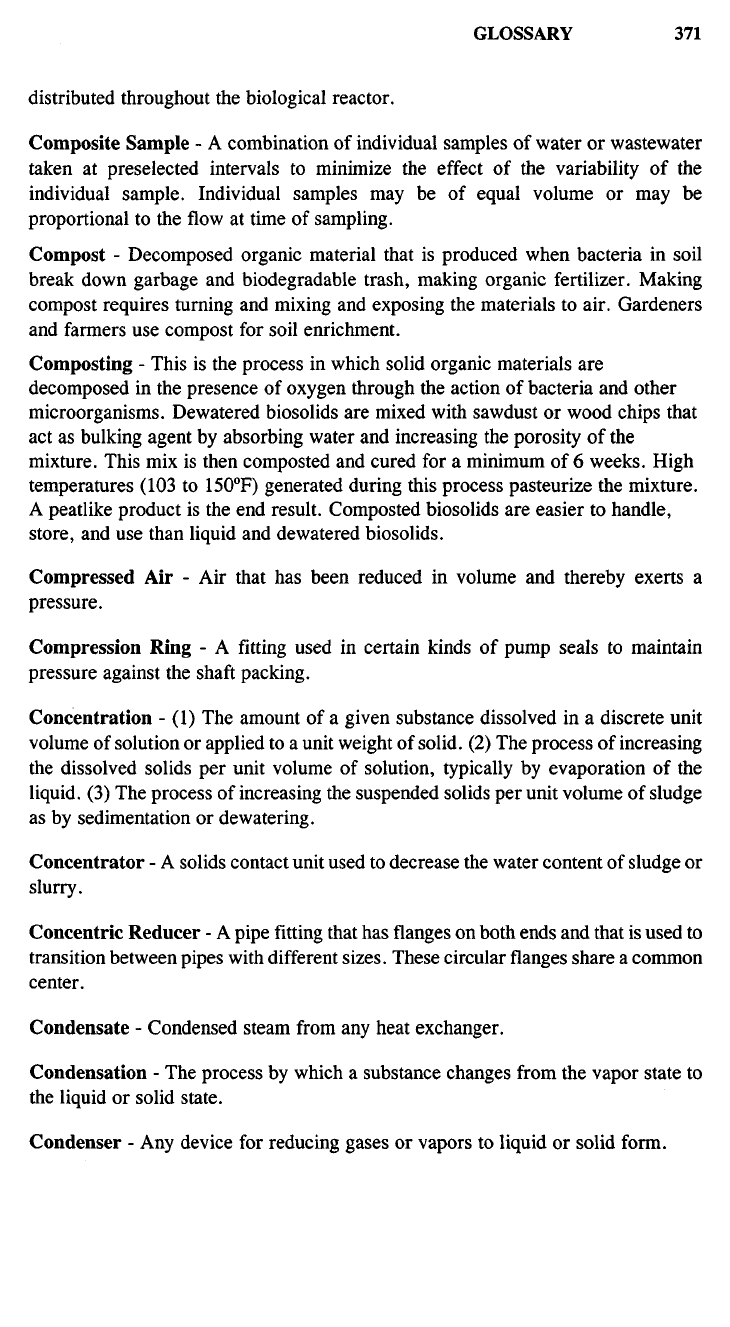
distributed throughout the biological reactor.
Composite Sample - A combination of individual samples of water or wastewater
taken at preselected intervals to minimize the effect of the variability of the
individual sample. Individual samples may be of equal volume or may be
proportional to the flow at time of sampling.
Compost - Decomposed organic material that is produced when bacteria in soil
break down garbage and biodegradable trash, making organic fertilizer. Making
compost requires turning and mixing and exposing the materials to air. Gardeners
and farmers use compost for soil enrichment.
Composting - This is the process in which solid organic materials are
decomposed in the presence of oxygen through the action of bacteria and other
microorganisms. Dewatered biosolids are mixed with sawdust or wood chips that
act as bulking agent by absorbing water and increasing the porosity of the
mixture. This mix is then composted and cured for a minimum of 6 weeks. High
temperatures (103 to 15O
0
F) generated during this process pasteurize the mixture.
A peatlike product is the end result. Composted biosolids are easier to handle,
store, and use than liquid and dewatered biosolids.
Compressed Air - Air that has been reduced in volume and thereby exerts a
pressure.
Compression Ring - A fitting used in certain kinds of pump seals to maintain
pressure against the shaft packing.
Concentration - (1) The amount of a given substance dissolved in a discrete unit
volume of solution or applied to a unit weight of solid. (2) The process of increasing
the dissolved solids per unit volume of solution, typically by evaporation of the
liquid. (3) The process of increasing the suspended solids per unit volume of sludge
as by sedimentation or dewatering.
Concentrator - A solids contact unit used to decrease the water content of sludge or
slurry.
Concentric Reducer - A pipe fitting that has flanges on both ends and that is used to
transition between pipes with different sizes. These circular flanges share a common
center.
Condensate - Condensed steam from any heat exchanger.
Condensation - The process by which a substance changes from the vapor state to
the liquid or solid state.
Condenser - Any device for reducing gases or vapors to liquid or solid form.

Conditionally Exempt Generators - Small quantity facilities that produce fewer
than 220 pounds of hazardous waste per month. Exempt from most regulations,
conditionally exempt generators are required to determine whether their waste is
hazardous and to notify local waste management agencies. These generators may
treat or dispose of the waste on site or ensure that the waste is sent to a permitted
disposal or recycling facility.
Conditioning - The chemical, physical, or biological treatment of sludges to
improve their dewaterability.
Conductivity - The ability of a substance to conduct heat or electricity. Electrical
conductivity is usually expressed in microsiemens per centimeter.
Cone of Depression - A lowering in the water table that develops around a pumped
well.
Connecting Rod - A plunger pump component that connects the shaft to the
plunger.
Consent Decree - A legal document submitted by the Department of Justice on
behalf of the EPA for approval by a federal judge to settle a case. A consent decree
can be used to formalize an agreement reached between EPA and potentially
responsible parties (PRPs) for cleanup at a Superfund site. Consent decrees also are
signed by regulated facilities to cease or correct certains actions or processes that are
polluting the environment and include payment of penalties. The Clean Water Act,
Clean Air Act, Toxic Substances Control Act, and others all use consent decrees.
Conservation - Preserving and renewing natural resources to ensure their highest
economic or social benefit over the longest period of time. Clean rivers and lakes,
wilderness areas, a diverse wildlife population, healthy soil, and clean air are natural
resources worth conserving for future generations.
Consistency - In the pulp/paper industry, a term for the density in percent by weight
dry matter, of a slurry of pulp.
Construction and Demolition Waste - Waste building materials, dredging
materials, tree stumps, and rubble resulting from construction, remodeling, repair,
and demolition operations on houses, commercial buildings and other structures, and
pavements. May contain lead, asbestos, or other hazardous materials.
Contact Stabilization - Contact stabilization is a modification of the conventional
activated sludge process. In contact stabilization, two aeration tanks are used. One
tank is for separate reaeration of the return sludge for at least 4 hours before it is
permitted to flow into the other aeration tank to be mixed with the primary effluent
requiring treatment.
Contact Tank - A tank used in water or wastewater treatment to promote contact
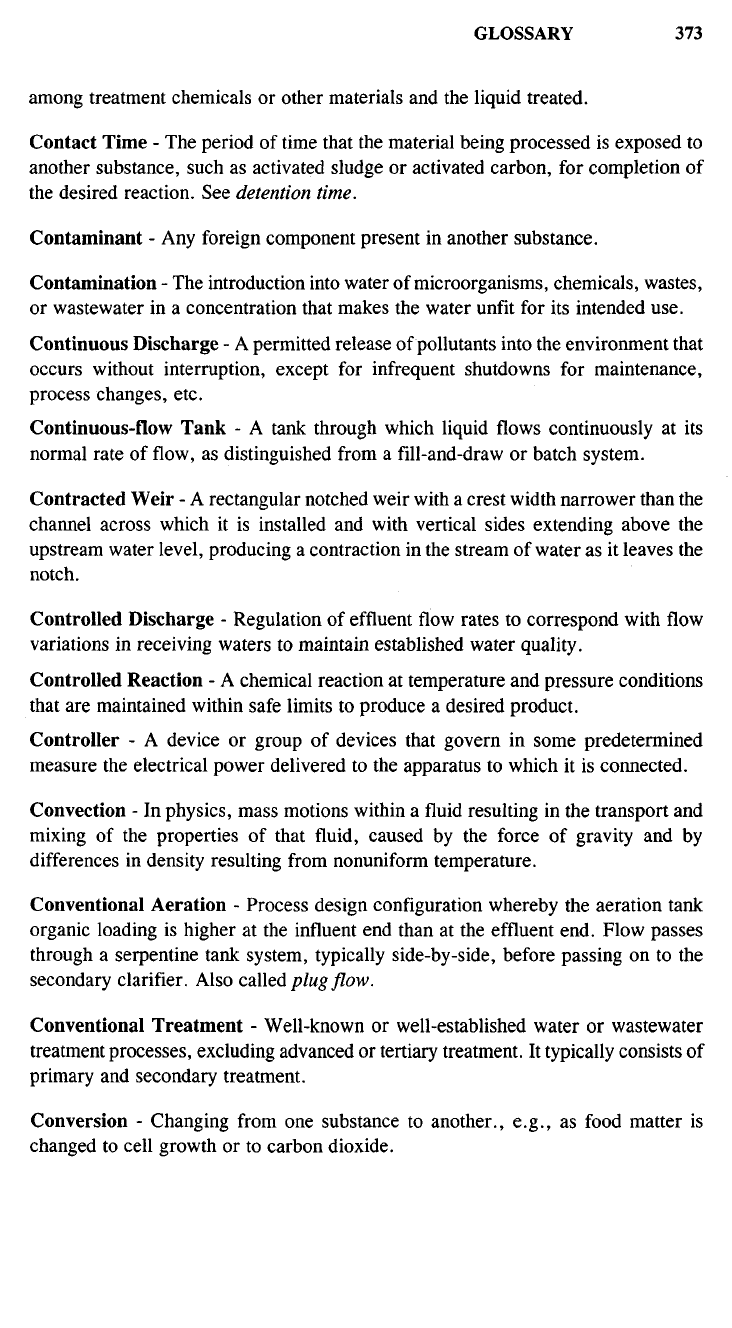
among treatment chemicals or other materials and the liquid treated.
Contact Time - The period of time that the material being processed is exposed to
another substance, such as activated sludge or activated carbon, for completion of
the desired reaction. See detention time.
Contaminant - Any foreign component present in another substance.
Contamination - The introduction into water of microorganisms, chemicals, wastes,
or wastewater in a concentration that makes the water unfit for its intended use.
Continuous Discharge - A permitted release of pollutants into the environment that
occurs without interruption, except for infrequent shutdowns for maintenance,
process changes, etc.
Continuous-flow Tank - A tank through which liquid flows continuously at its
normal rate of flow, as distinguished from a fill-and-draw or batch system.
Contracted Weir - A rectangular notched weir with a crest width narrower than the
channel across which it is installed and with vertical sides extending above the
upstream water level, producing a contraction in the stream of water as it leaves the
notch.
Controlled Discharge - Regulation of effluent flow rates to correspond with flow
variations in receiving waters to maintain established water quality.
Controlled Reaction - A chemical reaction at temperature and pressure conditions
that are maintained within safe limits to produce a desired product.
Controller - A device or group of devices that govern in some predetermined
measure the electrical power delivered to the apparatus to which it is connected.
Convection - In physics, mass motions within a fluid resulting in the transport and
mixing of the properties of that fluid, caused by the force of gravity and by
differences in density resulting from nonuniform temperature.
Conventional Aeration - Process design configuration whereby the aeration tank
organic loading is higher at the influent end than at the effluent end. Flow passes
through a serpentine tank system, typically side-by-side, before passing on to the
secondary clarifier. Also called plug flow.
Conventional Treatment - Well-known or well-established water or wastewater
treatment processes, excluding advanced or tertiary treatment. It typically consists of
primary and secondary treatment.
Conversion - Changing from one substance to another., e.g., as food matter is
changed to cell growth or to carbon dioxide.

Conveyance Loss - The loss of water from a conduit due to leakage, seepage,
evaporation, or evapotranspiration.
Copper Sulfate - Cupric sulfate, bluestone. Its major use in water treatment is as an
algaecide.
Copperas - An industrial by-product varying between manufacturers in chemical
content, impurities, and physical properties. The iron content is bivalent. Its use by
mistake instead of ferric sulfate could be harmful, since if not fully oxidized to the
ferric state it will carry through to the finished water. Both ferrous and ferric
sulfates can be called iron sulfate in generic terminology.
Copperas Chlorinated - Ferrous sulfate oxidized with chlorine in order to function
as a coagulant. Theoretically, 1 pound of chlorine is required to oxidize 8 pounds of
copperas. In practice, an excess of chlorine is needed. If the copperas is not totally
oxidized, soluble ferrous iron will carry through to the finished water.
Core Sampler - A long, slender pole with a foot valve at the bottom end that allows
the depth of the sludge blanket to be measured.
Correlation - The degree of relative correspondence, as between two sets of data.
Corrosion - A term usually used in reference to metals. It is the result of a chemical
or galvanic reaction in which the metal is solubilized or changed to a soluble metal
salt thereby losing weight and being weakened. Where iron is corroded in finished
water, the solubilized iron results in water quality problems.
Corrosion Control - (1) In water treatment, any method that keeps the metallic ions
of a conduit from going into solution, such as increasing the pH of the water,
removing free oxygen from the water, or controlling the carbonate balance of the
water. (2) The sequestration of metallic ions and the formation of protective films on
metal surfaces by chemical treatment.
Corrosive - A substance that eats or wears away materials gradually by chemical
action.
Corrosive Industrial Waste - Liquid waste that is sufficiently acidic or alkaline to
dissolve and wear away metal.
County Emergency Operations Plan - A plan required by Federal Emergency
Management Agency regulations that describes actions the county will take to
respond to emergency situations such as natural disasters, major fires, transportation
incidents, or chemical releases.
Coupling - A mechanical device for connecting two adjacent parts together, such as
connecting a motor to a shaft of a pump.
Next Page

Covered Facility - A facility having one or more of the 366 + extremely hazardous
substances in amounts higher than the quantity designated by EPCRA. These
facilities must file reports with the SERC and LEPC.
Cracking - An oil-refining process that breaks large molecules into smaller ones.
Cradle-to-Grave or Manifest System - A procedure in which hazardous wastes are
identified as they are produced and are followed through further treatment,
transportation, and disposal by a series of permanent, linkable, descriptive
documents.
Criteria - Descriptive factors taken into account by EPA in setting standards for
pollutants. For example, water quality criteria describe the concentration of
pollutants that most fish can be exposed to for an hour without showing acute
effects.
Critical Depth - The depth of water flowing in an open channel or partially filled
conduit corresponding to one of the recognized critical velocities.
Critical Flow -(I)A condition of flow in which the mean velocity is at one of the
critical values, ordinarily at Belanger's critical depth and velocity. Also used in
reference to Reynolds' critical velocities, which define the point at which the flow
changes from streamline or nonturbulent flows to turbulent flow. (2) The maximum
discharge of a conduit that has a free outlet and has the water ponded at the inlet.
Crops - Crops are plants grown for human or animal consumption and use. Crops
used directly for human consumption are those eaten by humans with only
superficial washing in water. Crops may be processed for human consumption by
many means, most of which reduce the likelihood of contact with or ingestion of
pathogens. Food chain crops are those crops ultimately used for food by humans and
other animals.
Cross Connection - (1) A physical connection through which a supply of potable
water could be contaminated or polluted. (2) A connection between a supervised
potable water supply and an unsupervised supply of unknown potability.
CRT - Cell residence time - the amount of time in days that an average bug remains
in the process. Also termed sludge age.
Cryogenic Oxygen Generation - The production of high-purity liquid oxygen by
cooling air to very low temperatures (i.e., 40 K).
Cryptosporidium - Cryptosporidium is also a parasite, found in the feces of warm-
blooded animals, including livestock, wildlife, and humans. The cyst form of
cryptosporidium is called an oocyst. Crytosporidium causes severe diarrhea which
can be fatal to immunocompromised persons (e.g. AIDS victims, elderly,
Previous Page
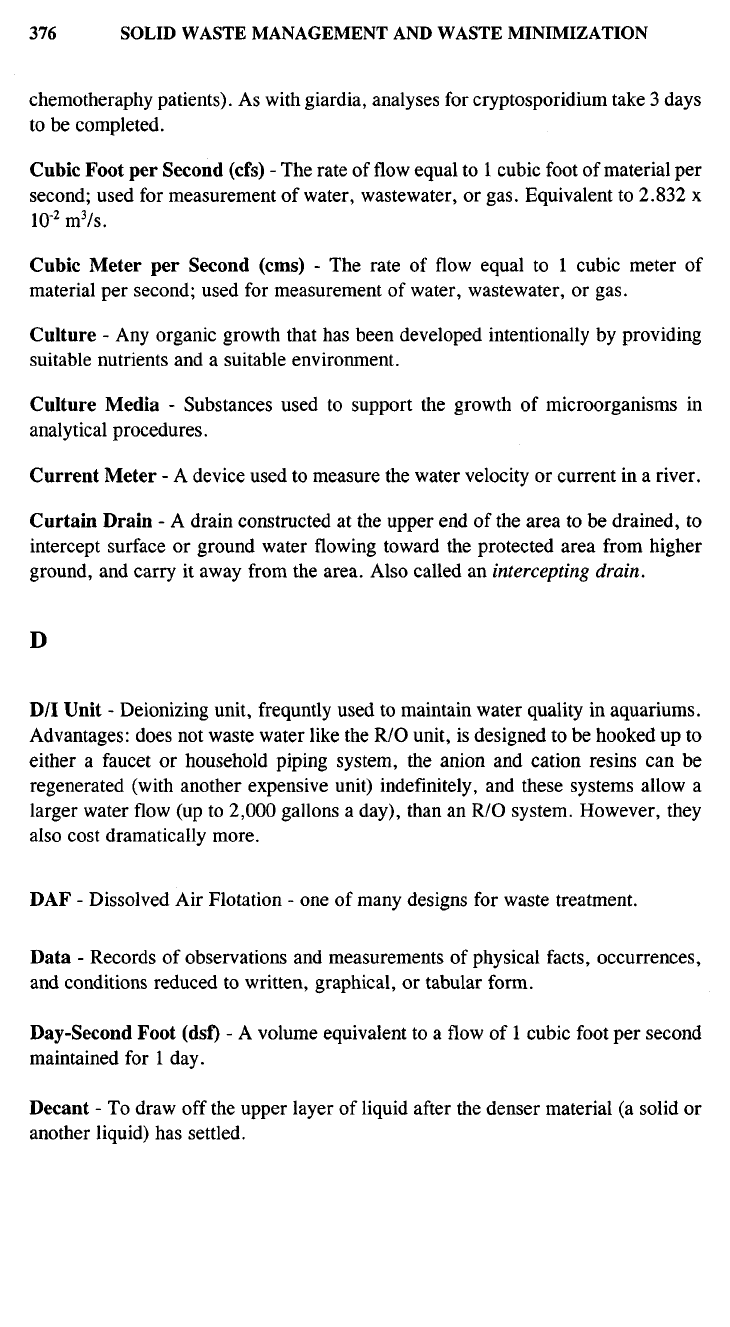
chemotheraphy patients). As with giardia, analyses for cryptosporidium take 3 days
to be completed.
Cubic Foot per Second (cfs) - The rate of flow equal to 1 cubic foot of material per
second; used for measurement of water, wastewater, or gas. Equivalent to 2.832 x
10-
2
m
3
/s.
Cubic Meter per Second (cms) - The rate of flow equal to 1 cubic meter of
material per second; used for measurement of water, wastewater, or gas.
Culture - Any organic growth that has been developed intentionally by providing
suitable nutrients and a suitable environment.
Culture Media - Substances used to support the growth of microorganisms in
analytical procedures.
Current Meter - A device used to measure the water velocity or current in a river.
Curtain Drain - A drain constructed at the upper end of the area to be drained, to
intercept surface or ground water flowing toward the protected area from higher
ground, and carry it away from the area. Also called an intercepting drain.
D
D/I Unit - Deionizing unit, frequntly used to maintain water quality in aquariums.
Advantages: does not waste water like the R/O unit, is designed to be hooked up to
either a faucet or household piping system, the anion and cation resins can be
regenerated (with another expensive unit) indefinitely, and these systems allow a
larger water flow (up to 2,000 gallons a day), than an R/O system. However, they
also cost dramatically more.
DAF - Dissolved Air Flotation - one of many designs for waste treatment.
Data - Records of observations and measurements of physical facts, occurrences,
and conditions reduced to written, graphical, or tabular form.
Day-Second Foot (dsf) - A volume equivalent to a flow of 1 cubic foot per second
maintained for 1 day.
Decant - To draw off the upper layer of liquid after the denser material (a solid or
another liquid) has settled.
